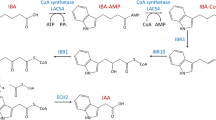Abstract
In the recent years medicinal plants are receiving attention due to the presence of therapeutically important active contents; however over exploitation is the major concern for conservation of several medicinal species. An attempt has been made to develop a propagation method through air layering in Zanthoxylum armatum DC, a medicinally important plant used in various traditional and modern medicines. Various concentrations of auxins as indole-3-butyric acid (IBA) and α-naphthalene acetic acid (NAA) at 0.01, 0.05, 0.1, 0.5 and 1.0 mM each were applied to the stem branches (still attached to the plant) during the rainy season and following root formation, the stems were detached from mother plants and transplanted in the soil (under mist chamber conditions). Plants treated with 0.1 mM NAA resulted in maximum plant survival (90 %), root number (142 ± 6.74) and root length (16.8 ± 1.04 cm) in 28 weeks. The higher concentrations of the IBA and NAA (0.5 mM) significantly decreased the percentage rooting and no root formation was observed in 1.0 mM concentration. The results of the present study can be used for mass multiplication of the species as an inexpensive and convenient way of propagation.

Similar content being viewed by others
References
Anonymous (1976) The wealth of India-A dictionary of Indian raw materials & industrial products raw materials. Council of scientific and industrial research, New Delhi, vol. XI: (X-Z). 11:17–25
Chen IS, Lin YC, Tsai IL, Teng CM, Ko FN, Ishikawa T, Ishii H (1995) Coumarins and anti- platelet aggregation constituents from Zanthoxylum schinifolium. Phtyochemistry 39:1091–1097
Chen IS, Wu SJ, Tsai IL (1998) Chemical and bioactive constituents from Zanthoxylum simulans. J Nat Prod 57:1206–1211
Islam JKN, Ahsan N (1997) Biological activities of the secondary metabolites isolated from Zieria smithii and Zanthoxylum elephantiasis on microorganisms and brine shrimps. Physiother Res 11:64–66
Hisatomi E, Matsui M, Kobayashi A, Kubota K (2000) Antioxidative activity in the pericarp and seed of Japanese pepper (Zanthoxylum piperatum). J Agric Food Chem 48:4924–4928
Kala CP (2010) Assessment of availability and patterns in collection of Timroo (Zanthoxylum armatum DC.): a case study of Uttarakhand Himalaya. Med Plants 2:91–96
Samant SS, Pal M (2003) Diversity and conservation status of medicinal plants in Uttaranchal State. Indian For 129:1090–1108
Samant SS, Butola JS, Sharma A (2007) Assessment of conservation diversity, A Status and preparation distribution of management plan for medicinal plants in the catchment area of parbati hydroelectric project stage–III in Northwestern Himalaya. J Mt Sci 4:34–56
Frances A (2004) Seed storage characteristics and germination of south florida native plant seeds. Fairchild tropical botanic garden. http://www.ftg.org/PDF20Files/SeedStorageBehavior
Purohit VK, Nandi SK, Palni LMS, Bag N, Rawat DS (2004) Successful air layering in Myrica esculenta— a simple and clonal method of propagation. Nat Acad Sci Lett 27:205–208
Purohit VK, Palni LMS, Rikhari HC, Nandi SK (2005) Rooting of air layering shoots of Quercus glauca Thumb and subsequent performance of such plants and seedlings under different microclimatic conditions. Indian For 131:786–796
Loach K (1988) Controlling environmental conditions to improve adventitious rooting. In: Davis TD, Haissig BE, Sankhla N (eds) Adventitious root formation in cuttings. Dioscorides Press, Portland, pp 248–273
Blazich FA (1988) Chemicals and formulations used to promote adventitious rooting. In: Davis TD, Haissig BE, Sankhla N (eds) Adventitious root formation in cuttings. Dioscorides Press, Portland, pp 132–149
Gurumurthi K, Gupta BB, Kumar A (1984) Hormonal regulation of root formulation. In: Purohit SS (ed) Hormonal regulation of plant growth and development. Agrobotanical Publishers, India, pp 387–400
Gupta VK, Solanki KR, Kumar RV, Dutta A (1998) Propagation Neem (Azadirachita indicia) by air layering. For Farm Commun Tree Res Rep 3:29–32
Ansari SA, Kumar P, Mandal AK, Kumar P (1998) An air layering method for clonal propagation of Albizia procera. Indian For 12:354–356
Bhojvaid PP, Negi S (2003) Propagation of Elaeocarpus granitus by air layering. Indian For 129:1185–1191
Ahlawat SP, Gupta VK, Kumar RV, Dutta A (2003) Vegetative propagation of Acacia nilotica (L) spp, indica through air layering. Indian J Agrofor 5:106–108
Davis TD (1988) Photosynthesis during adventitious rooting. In: Davis TD, Haissig BE, Sankhla N (eds) Adventitious root formation in cuttings. Dioscorides Press, Portland, pp 30–43
Hartman HT, Kester DE, Davies FT, Geneve RL (2002) Plant propagation: principles and practices. Pearson Education, Inc., Upper Saddle River, New Jersey, p 880
Acknowledgments
The authors are thankful to the Director, G.B. Pant Institute of Himalayan Environment and Development, Kosi-Katarmal, Almora, MoEF&CC, Govt. of India, New Delhi for facilities; and Uttarakhand State Council for Science and Technology, Dehradun is thanked for financial assistance. The authors declare that there is no conflict of interest.
Author information
Authors and Affiliations
Corresponding author
Rights and permissions
About this article
Cite this article
Purohit, S., Bhatt, A., Bhatt, I.D. et al. Propagation Through Air Layering in Zanthoxylum armatum DC: An Endangered Medicinal Plant in the Himalayan Region. Proc. Natl. Acad. Sci., India, Sect. B Biol. Sci. 86, 607–610 (2016). https://doi.org/10.1007/s40011-015-0493-1
Received:
Revised:
Accepted:
Published:
Issue Date:
DOI: https://doi.org/10.1007/s40011-015-0493-1




